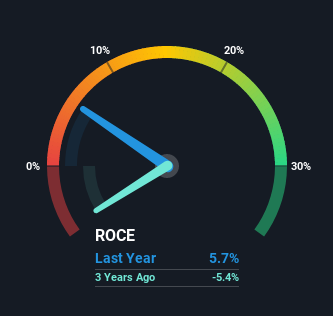Slowing Rates Of Return At Australian Agricultural Projects (ASX:AAP) Leave Little Room For Excitement
To find a multi-bagger stock, what are the underlying trends we should look for in a business? Firstly, we'll want to see a proven return on capital employed (ROCE) that is increasing, and secondly, an expanding base of capital employed. Put simply, these types of businesses are compounding machines, meaning they are continually reinvesting their earnings at ever-higher rates of return. In light of that, when we looked at Australian Agricultural Projects (ASX:AAP) and its ROCE trend, we weren't exactly thrilled.
What is Return On Capital Employed (ROCE)?
If you haven't worked with ROCE before, it measures the 'return' (pre-tax profit) a company generates from capital employed in its business. To calculate this metric for Australian Agricultural Projects, this is the formula:
Return on Capital Employed = Earnings Before Interest and Tax (EBIT) ÷ (Total Assets - Current Liabilities)
0.057 = AU$808k ÷ (AU$17m - AU$3.0m) (Based on the trailing twelve months to June 2021).
Thus, Australian Agricultural Projects has an ROCE of 5.7%. Even though it's in line with the industry average of 5.7%, it's still a low return by itself.
Check out our latest analysis for Australian Agricultural Projects

While the past is not representative of the future, it can be helpful to know how a company has performed historically, which is why we have this chart above. If you're interested in investigating Australian Agricultural Projects' past further, check out this free graph of past earnings, revenue and cash flow.
What Can We Tell From Australian Agricultural Projects' ROCE Trend?
In terms of Australian Agricultural Projects' historical ROCE trend, it doesn't exactly demand attention. The company has consistently earned 5.7% for the last five years, and the capital employed within the business has risen 65% in that time. This poor ROCE doesn't inspire confidence right now, and with the increase in capital employed, it's evident that the business isn't deploying the funds into high return investments.
On a side note, Australian Agricultural Projects has done well to reduce current liabilities to 17% of total assets over the last five years. This can eliminate some of the risks inherent in the operations because the business has less outstanding obligations to their suppliers and or short-term creditors than they did previously.
In Conclusion...
In summary, Australian Agricultural Projects has simply been reinvesting capital and generating the same low rate of return as before. And investors may be recognizing these trends since the stock has only returned a total of 4.8% to shareholders over the last five years. Therefore, if you're looking for a multi-bagger, we'd propose looking at other options.
If you want to know some of the risks facing Australian Agricultural Projects we've found 5 warning signs (3 can't be ignored!) that you should be aware of before investing here.
For those who like to invest in solid companies, check out this free list of companies with solid balance sheets and high returns on equity.
New: Manage All Your Stock Portfolios in One Place
We've created the ultimate portfolio companion for stock investors, and it's free.
• Connect an unlimited number of Portfolios and see your total in one currency
• Be alerted to new Warning Signs or Risks via email or mobile
• Track the Fair Value of your stocks
Have feedback on this article? Concerned about the content? Get in touch with us directly. Alternatively, email editorial-team (at) simplywallst.com.
This article by Simply Wall St is general in nature. We provide commentary based on historical data and analyst forecasts only using an unbiased methodology and our articles are not intended to be financial advice. It does not constitute a recommendation to buy or sell any stock, and does not take account of your objectives, or your financial situation. We aim to bring you long-term focused analysis driven by fundamental data. Note that our analysis may not factor in the latest price-sensitive company announcements or qualitative material. Simply Wall St has no position in any stocks mentioned.
About ASX:AAP
Australian Agricultural Projects
Operates and manages olive groves in Boort, Victoria.
Excellent balance sheet and good value.
Market Insights
Community Narratives





